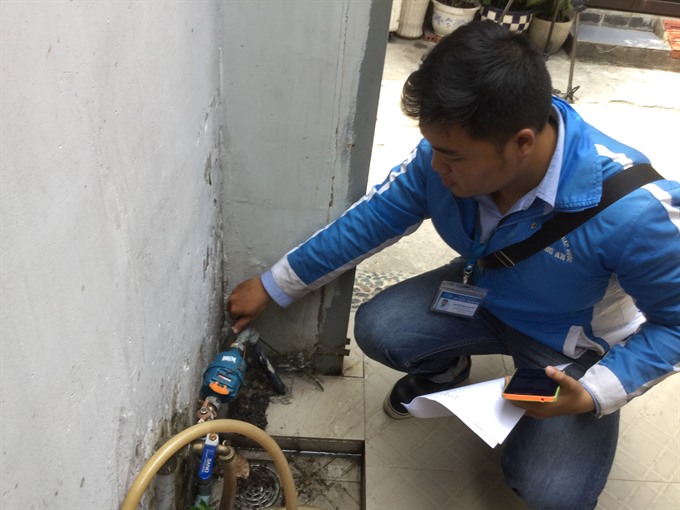 Society
Society

In an effort to provide clean water to all households, HCM City in recent years has connected nearly all households in the city to water pipelines and meters for free. But more than 100,000 households in the city continue to use well water, mostly out of habit, according to city officials.
 |
| Caption: An employee of Trung An Water Supply Joint-Stock Company checks water usage at a house in Gò Vấp District connected to a city water pipeline and meter, installed for free by HCM City authorities. The household uses well water only despite access to tap water. — VNS Photo Gia Lộc |
Gia Lộc
HCM CITY — In an effort to provide clean water to all households, HCM City in recent years has connected nearly all households in the city to water pipelines and meters for free. But more than 100,000 households in the city continue to use well water, mostly out of habit, according to city officials.
Nguyễn Thị Thanh Thủy (not her real name) of Gò Vấp District is one of many residents who use well water and store it in a container linked to her pipes indoors.
“I don’t want to pay for tap water,” Thủy said, adding that the well water was much cheaper.
Each month, she pays VNĐ300,000 (US$13) for electricity usage, mainly from her air conditioner, fridge, washing machine and water pump.
“Also, my family doesn’t like the smell of chlorine used to purify tap water,” she said.
Trương Xánh of Gò Vấp District said that he uses tap water for cooking on the ground floor, connected to a city pipeline. His monthly usage bill is for only two cubic metres of water.
For the second and third floors, the water pressure is too low to use tap water with the old, existing pipes, he said.
In February, more than 102,900 of nearly 1.3 million water meters at households in the city showed that owners had not used even one cubic metre of water, according to Sài Gòn Water Corp (SAWACO).
More than 137,000 of the 1.3 million meters recorded only one to four cubic metres of usage.
Most households refusing to use tap water are located in the districts of Hóc Môn, Gò Vấp, Bình Tân and Bình Chánh.
Experts have warned that exploiting more than 500,000 cubic metres of underground water per day in the city is leading to a high risk of subsidence in many areas.
That level has already been reached. More than 543,000 cubic metres of underground water are exploited daily, according to the city’s Department of Environment and Natural Resources.
The department said that last year the city had a total of 7,200 hectares damaged by depression in the districts of Hóc Môn, Bình Tân, Bình Thạnh, Bình Chánh, Nhà Bè, and District 8.
In a meeting with SAWACO last month, HCM City Party Secretary Đinh La Thăng told the department to develop a roadmap on detailed methods to stop or ban exploitation of underground water sources.
Administrative sanctions and fines should be imposed on violators, he added.
Nguyễn Minh Hải of Trung An Water Supply Joint Stock Company said that most households in the city can afford tap water payments. Families with permanent and temporary residential books are provided a quota of four cubic metres of water at the price of VNĐ6,095 ($0.3) per person.
“Even so, many people do not use tap water. They have had the habit of using well water for a long time,” Hải said.
“It is a waste of capital for SAWACO to install water pipelines and meters at households which do not use tap water. On average, VNĐ7 million or 8 million ($307- 351) must be spent for each installation,” he added.
The company’s employees are working with local authorities to set up meetings with residents to encourage them to use tap water.
Two more water plants, Kênh Đông and Thủ Đức 4, are under construction and expected to be completed in 2018. Moreover, more than 1,000 kilometres of water pipelines will be built by 2019.
SAWACO has increased the total capacity of water supply for city residents, from 1.34 million cubic metres per day in 2009 to 2.4 million cubic metres per day now.
Well-water quality
The HCM City Preventive Health Centre said that inspections of well water in households in February showed that 14 of 24 water samples failed to meet pH standards of 6.0 to 8.5 under the Ministry of Health’s regulations.
One sample of water from a well in Bình Tân District contained E.coli bacteria, which causes acute diarrhea and other symptoms.
In the first eight months of last year, the centre tested 197 well water samples in the districts of 12, Gò Vấp, Tân Bình, Tân Phú and Hóc Môn. Of these, 42 per cent contained a low pH, which can damage tooth enamel and cause itching.
Around 9 per cent of the water samples had ammonia concentration exceeding the standard of three milligrammes per litre.
Water samples in the districts of 12 and Hóc Môn had the highest concentration of iron. — VNS